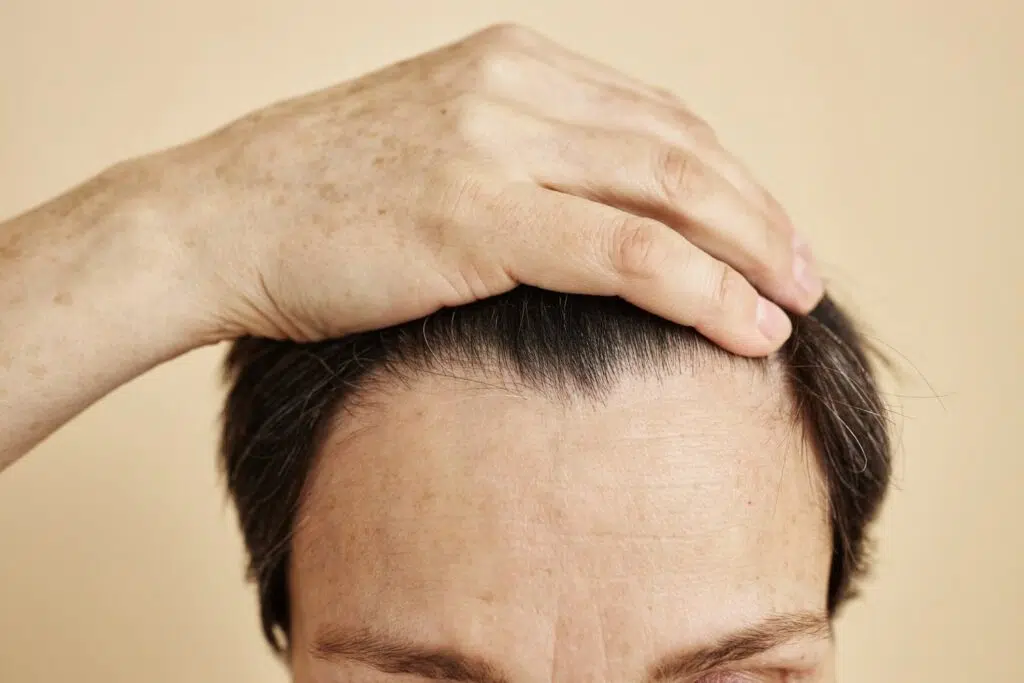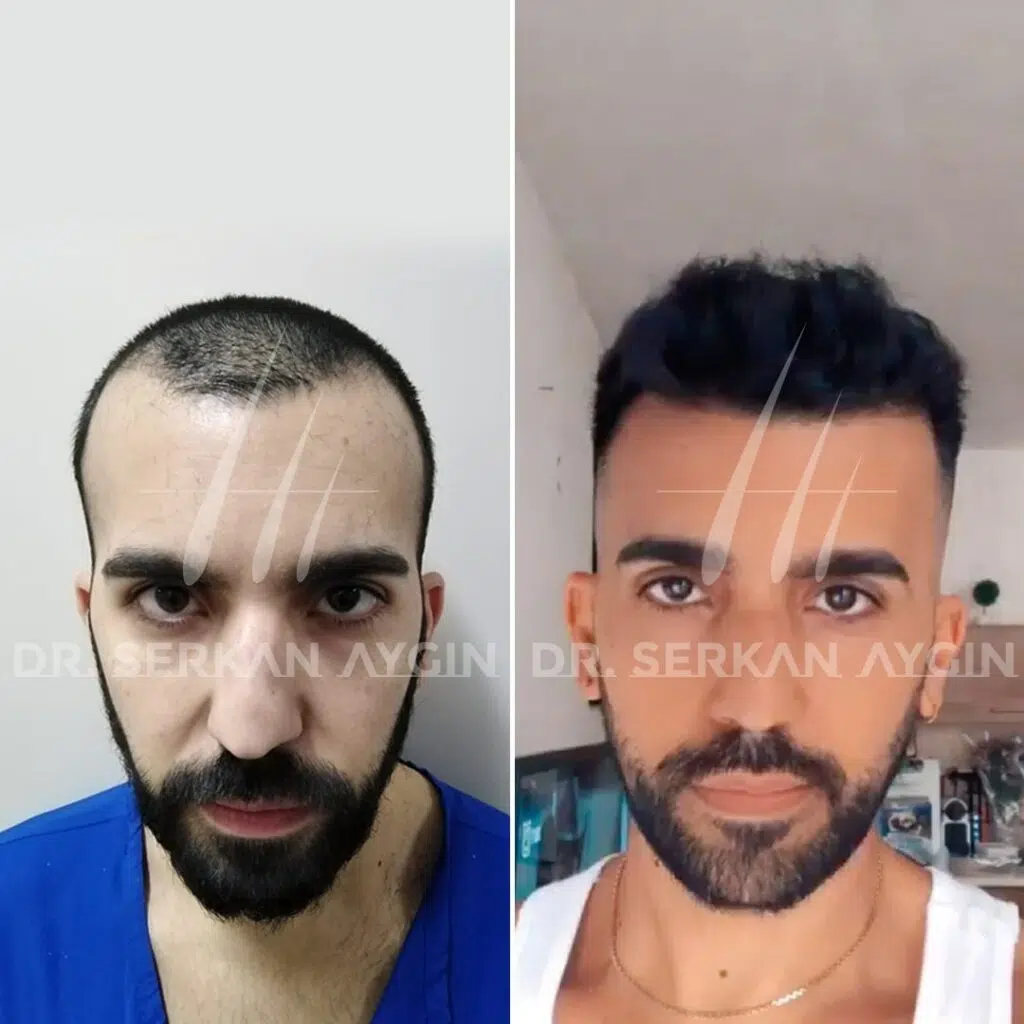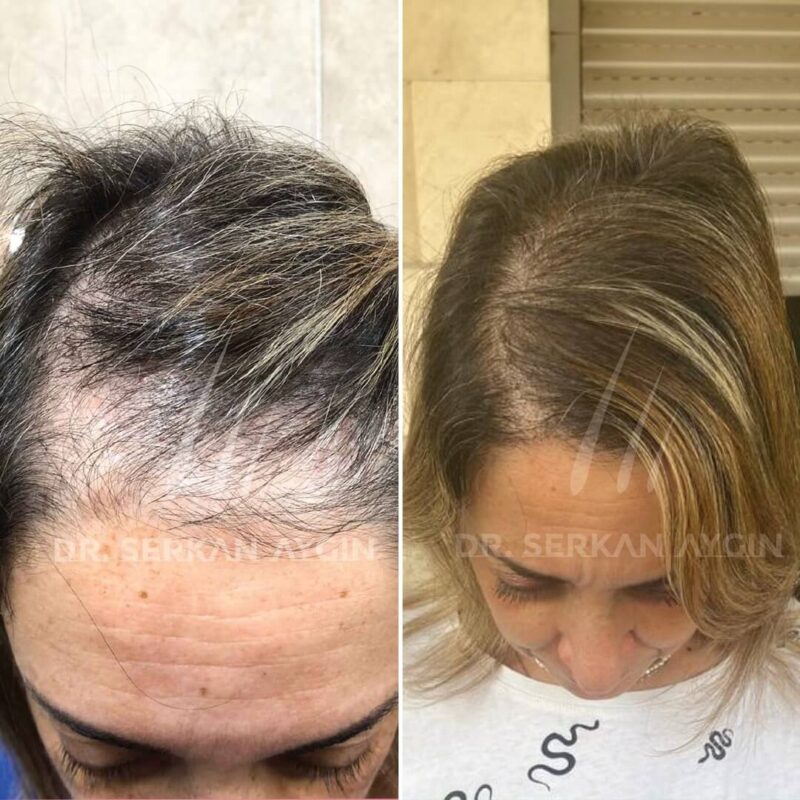Receding hairlines are a widespread aesthetic issue, affecting nearly 40 to 50 percent of men from the age of 20, and a significant number of ladies as well. This often leads to the question: how can you fill in a receding hairline?
Thanks to advancements in technology, experts can now effectively address receding hairlines. In this article, we’ll explore the causes of receding hairlines, discuss what you can do about them, and delve into the DHI hair transplantation method.
What Causes a Receding Hairline?
The medical term for bald or thinning areas that typically appear at the hairline above the temples is “calvities frontalis.” This often progresses to a bald forehead, and over time, the hair around the crown is also affected, leading to a “tonsure” (a circular bald patch). Ultimately, only a horseshoe-shaped ring of hair remains.
Often, this is hereditary hair loss, which can be exacerbated by stress, nicotine, an unhealthy diet, and alcohol. A receding hairline usually marks the beginning of hair loss, medically known as androgenetic alopecia. In most cases, it’s hormonally induced in men.
This occurs due to an androgenetic and sometimes hereditary hypersensitivity to the hormone Dihydrotestosterone(DHT). The hair root’s reaction to this hormone varies from person to person. The hormone’s blood level also depends on personal lifestyle and age. In many cases, increased sensitivity and high DHT levels go hand in hand. In men, elevated DHT can lead to a receding hairline at an early age. For women with receding hairlines, hair loss often occurs during pregnancy and, particularly, during menopause.
How Can I Stop a Receding Hairline?

What you can do about a receding hairline depends on its cause. In some cases, hair can regrow on its own, for example, if the hair loss is due to a reversible hormonal imbalance. Once the balance is restored, the hair often grows back. However, if it’s hereditary hair loss, it’s a progressive problem that can potentially be slowed down but not entirely stopped.
Filling in a Receding Hairline Without Surgery
You can camouflage thinning or bald spots with hairpieces, powders, hair dyes, or by choosing a suitable hairstyle. There are various ways you can “fill in” your receding hairline. As long as you still have active hair follicles, you can medically treat calvities frontalis with Finasteride or Minoxidil. However, these can sometimes cause significant side effects and are often only temporary solutions.
For milder cases that don’t require surgery, you can opt for the following non-surgical medical treatments:
- LLLT (Low-Level Laser Therapy)
- Mesotherapy
- PRP Treatment (Platelet-Rich Plasma Therapy)
Filling in a Receding Hairline with Surgery
If your hair loss is advanced according to the Hamilton-Norwood scale (the scientific scale for hair loss), a hair transplantmight be a suitable option. However, this is usually only considered if all other treatments have been ineffective and after consulting with a specialized trichologist or dermatologist.
There are three main methods:
- FUE (Follicular Unit Extraction)
- DHI (Direct Hair Implantation)
- FUT (Follicular Unit Transplantation) –Not explicitly mentioned in the original text but a common method.
FUE involves extracting individual hair follicles from the back of the head (where hair is less susceptible to DHT) and manually implanting them into bald or thinning areas using forceps.
DHI hair transplantation is a secure and permanent solution for receding hairlines. The DHI method is considered one of the world’s leading hair transplantation procedures and is particularly effective. With this method, the transplanted hairs typically last a lifetime and do not fall out again.
Solutions for Receding Hairline Women
Female hair loss often presents as diffuse thinning, mostly affecting the head’s middle line and hairline. Female pattern baldness is visually represented in the Ludwig Scale. For ladies receding hairline concerns are addressed in specific ways, different to men’s.
Long DHI for Women
The Long DHI (Direct Hair Implantation) method is specific for women seeking to address hair loss without shaving. Long DHI bypasses this concern, allowing a discreet and seamless restoration.
How does Long DHI work for women with receding hairlines?
Similar to the standard DHI method. The key difference is that with Long DHI, the hair grafts are extracted and implanted without shaving the hair shafts.
The process involves:
Precise Extraction: Individual hair follicles are meticulously extracted from a healthy donor area.
Direct Implantation: These unshaven grafts are then loaded into the DHI implanter pen and directly implanted into the thinning areas of the receding hairline.
Minimized Downtime and Visibility: Since no shaving is required, women can often return to their daily routines very quickly.
Why Long DHI is Ideal for Receding Hairline in Women
No Shaving Required: This is arguably the biggest benefit for women, allowing them to maintain their current hairstyle and discreetly undergo the procedure.
Natural-Looking Results: The precision of the DHI implanter ensures that the transplanted hair grows in the correct direction and at the natural angle, leading to natural outcomes for a receding hairline.
High Graft Survival Rate: The rapid implantation of follicles contributes to a higher survival rate of the transplanted grafts, resulting in denser and more robust growth.
Minimally Invasive: The procedure is gentle on the scalp, leading to faster healing and minimal discomfort.
Tailored to Female Hair Loss Patterns: As female hair loss often involves diffuse thinning rather than distinct bald patches, the Long DHI method allows for strategic and precise placement of grafts.
How the DHI Method Compares to the FUE Method

Direct Hair Implantation (DHI) represents significant medical progress. In hair surgery, DHI hair transplantation has become the most advanced hair implantation method worldwide.
The treatment consists of two phases:
- Specialist extraction of follicular units.
- Implantation of the extracted units.
Compared to other methods, about 95 percent of the implanted hair follicles survive. The final results of this hair transplantation method are usually visible after one year, with new hairs growing as early as two months. After the session, only minimal post-operative medication is needed.
Cost of Filling in a Receding Hairline
The cost of addressing a receding hairline varies significantly depending on the chosen method, the extent of hair loss, and the clinic or provider. Here’s an overview of common treatments and their costs in Germany, Austria, and Switzerland, along with a comparison to Turkey hair transplant cost.
Treatment Method | Cost per Session (DACH) | Total Cost (DACH) | Cost in Turkey (FUE/DHI) | Notes |
PRP Therapy | €300 – €1,200 | €600 – €7,200 (for 2-6 sessions) | Not applicable for hair transplants | Multiple sessions needed, autologous blood treatment |
Mesotherapy | €150 – €400 | €900 – €3,200 (for 6-8 sessions) | From €86 – €223 (per session) | Multiple sessions needed, injection of active ingredients |
Low-Level Light Therapy (LLLT) | €50 – €99 | Variable, often in combo packages | Not listed separately | Supportive therapy, often as an add-on |
Minoxidil | N/A (per pack) | €50 – €80 (3-month supply) | N/A | Ongoing application, over-the-counter |
FUE Hair Transplantation | €3,000 – €10,000 | One-time | €1,500 – €3,500 | Cost depends on graft count and effort |
DHI Hair Transplantation | €3,900 – €15,900 | One-time | €2,000 – €5,000 | Higher precision, potentially denser results |
Non-Surgical Treatments:
- PRP Therapy (Platelet-Rich Plasma):This method involves taking your own blood, centrifuging it to extract platelet-rich plasma, and then injecting it into the scalp to stimulate hair growth.
- Cost per session:Between €300 and €1,200.
- Number of sessions:Usually 2 to 6 sessions are required. Booster treatments can later cost between €150 and €300 per session.
- Mesotherapy:This involves injecting vitamins, minerals, and other active ingredients directly into the scalp to strengthen hair follicles and promote growth.
- Cost per session:Approximately €150 to €400.
- Number of sessions:Typically, 6 to 8 sessions are recommended, which can lead to total costs of up to €2,400.
- Low-Level Light Therapy (LLLT):This therapy uses special laser or LED devices to stimulate hair growth with light energy. It’s often offered as a supportive measure or in combination with other therapies. Costs are frequently included in combination packages or are around €50 to €99 per session.
- Minoxidil:This is a topical medication applied directly to the scalp that can stimulate hair growth. It’s available over-the-counter in pharmacies.
- Cost:A 3-month supply (3×60 ml) in Germany, Austria, and Switzerland costs about €50 to €80. It requires ongoing application.
Surgical Treatments (Hair Transplants):
Hair transplants are the most effective method for permanently addressing a receding hairline. Costs heavily depend on the number of grafts (hair follicle units) needed and the chosen technique.
- FUE Hair Transplantation (Follicular Unit Extraction):In this method, individual hair follicles are extracted from the donor area and transplanted into the bald spots.
- Cost in Germany:Between €3,000 and €10,000, depending on the graft count. For 1500 grafts, costs are around €4,800; for 2500 grafts, about €7,000.
- Cost in Austria:An average of €8,634 for 2500 grafts.
- Cost in Switzerland:An average of CHF 9,456 for 2500 grafts.
- DHI Hair Transplantation (Direct Hair Implantation):An advancement of the FUE method, where hair follicles are implanted directly with a special implanter pen. This allows for more precise placement and often a higher hair density.
- Cost in Germany:Between €3,900 and €15,900.
- Cost in Austria and Switzerland:Similar to FUE, often tending to be slightly higher due to the precision.
Costs in Turkey:
Turkey has become a popular destination for hair transplants due to significantly lower costs compared to Western Europe.
- FUE Hair Transplantation in Turkey:Typically between €1,500 and €3,500 for a complete treatment (often all-inclusive hair transplant Turkey packages including accommodation and transfer).
- DHI Hair Transplantation in Turkey:Prices usually range from €2,000 to €5,000.
Addressing Your Receding Hairline with Dr. Serkan Aygin in Istanbul
Dr. Serkan Aygin is a pioneer in hair transplantation in Turkey, with 25 years of experience in the field. He’s a leading expert in this sector, specializing in hair transplantation after extensive experience in dermatology.
On our website, you can find hair transplant before and afters from some of our patients, showcasing Dr. Aygin’s skills. If you’re experiencing hair loss and want to address your receding hairline, contact our specialized clinic today and say goodbye to your receding hairline for good.


